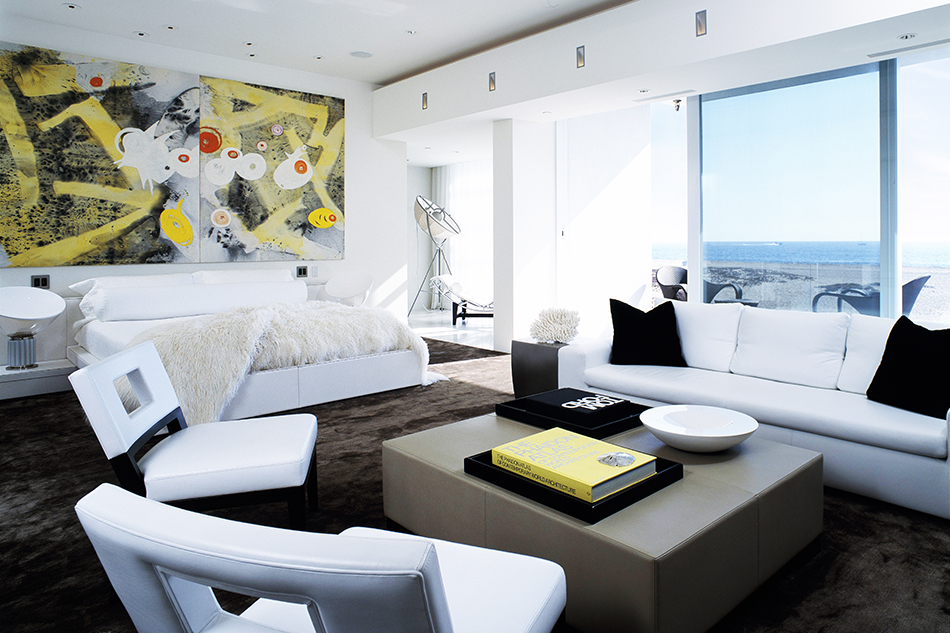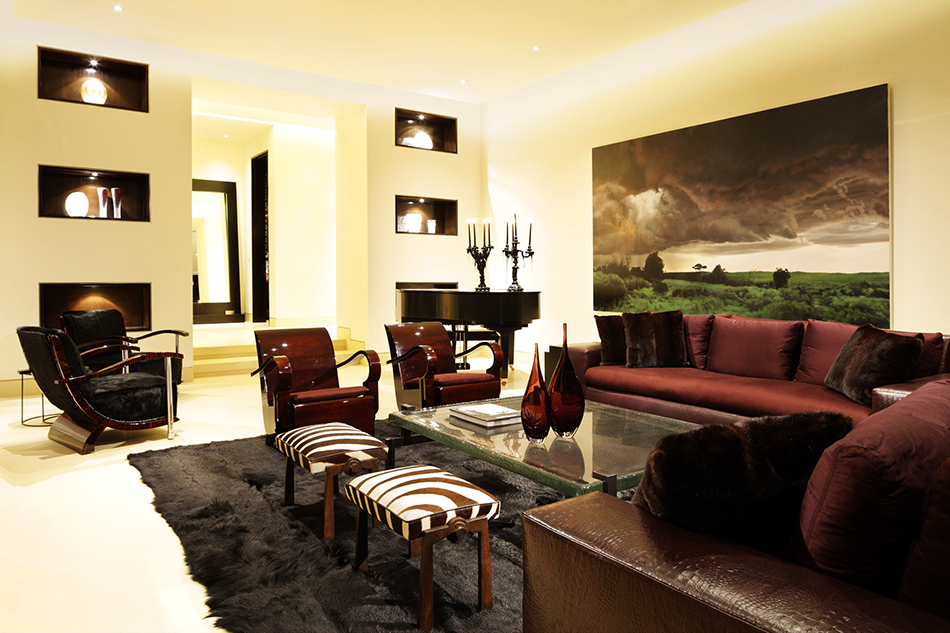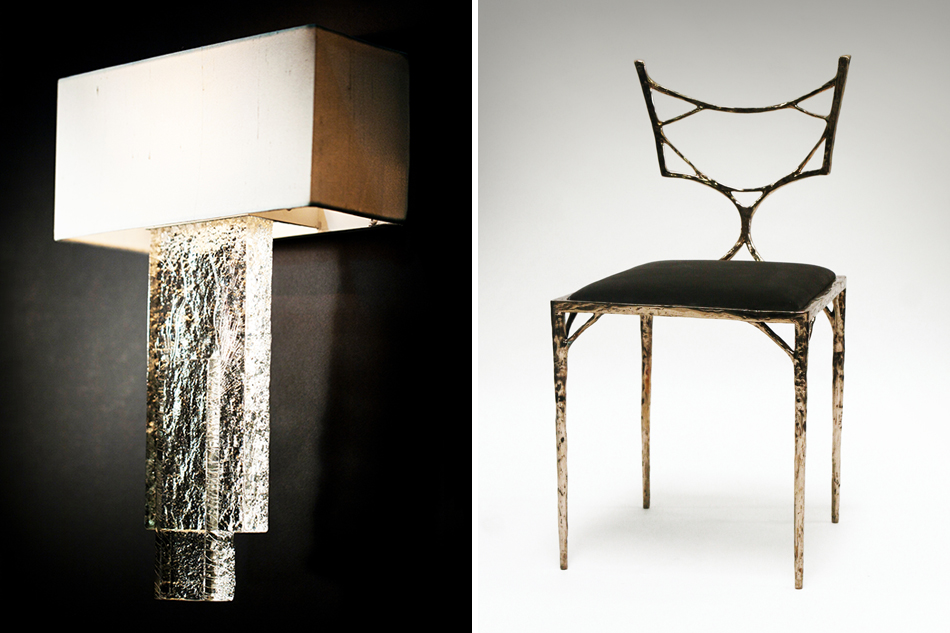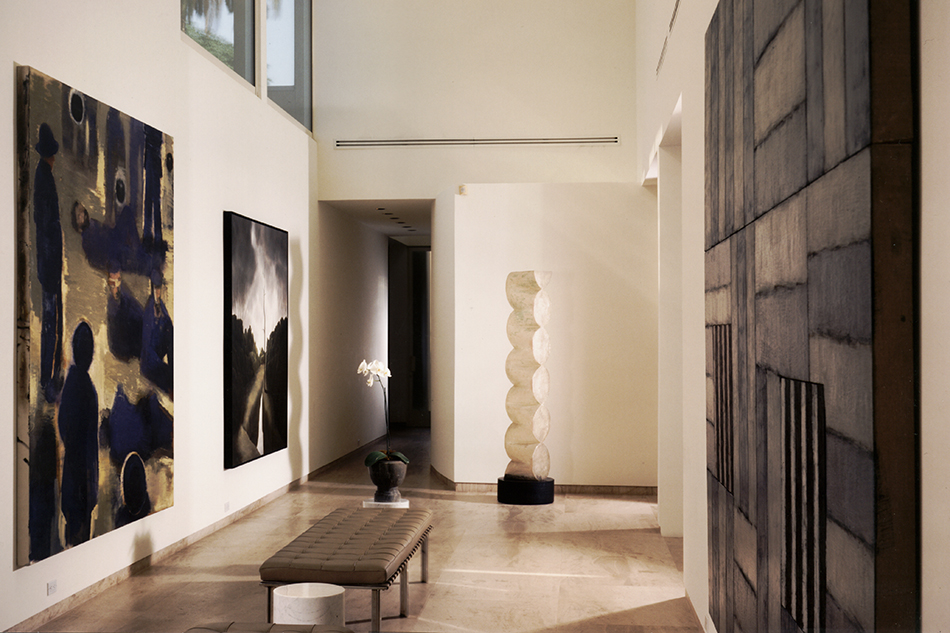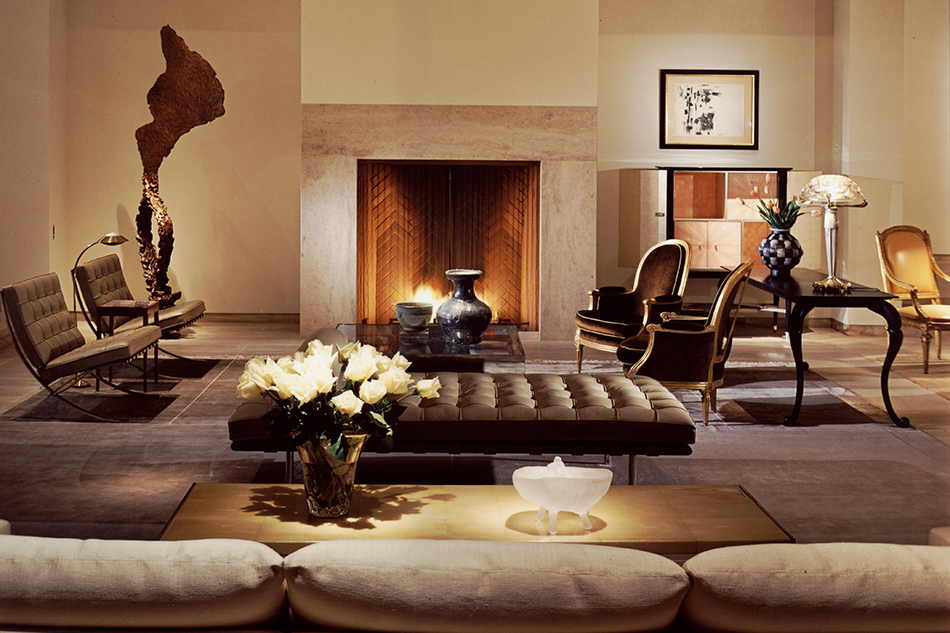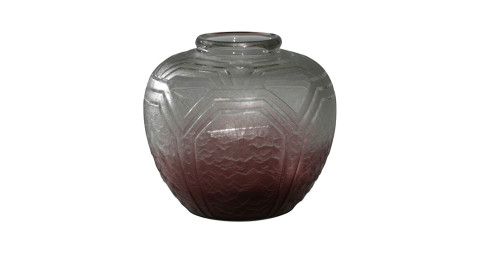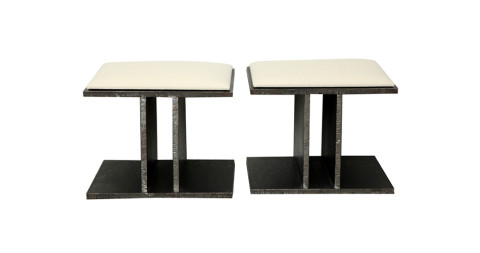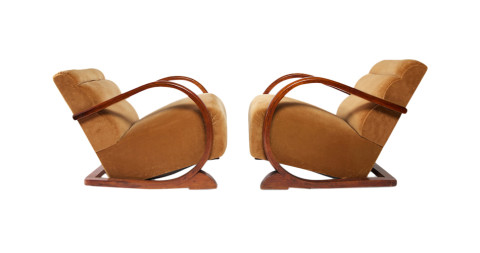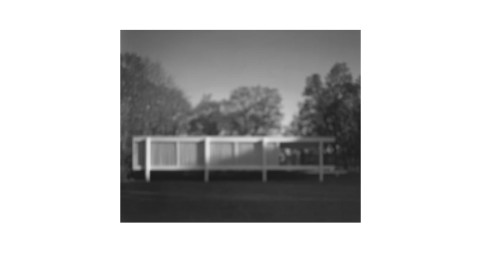
March 13, 2013Top: Not afraid to combine disparate styles and time periods, Magni used the Glass House coffee table from his own home collection to separate two Mies van der Rohe Barcelona chairs and a pair of late-18th-century bergères at a Beverly Hills residence. Photo by Mary E. Nichols
Quick! Name a famous sculptor born and raised in Omaha, Nebraska. The futility of this exercise demonstrates the difficulty James Magni — who says he wanted to be a sculptor “since age zero” — faced as an artistically inclined child growing up during the 1960s and ’70s in a state better known for bringing the world fat prime steaks, Kool-Aid and CliffsNotes.
In fact, recalls Magni, “It was painful. I did not fit in. My life was in my room, where I’d spend my time printmaking, carving sculptures from large chunks of wood and painting bleak scenes of snow and barren trees.” Yet Magni found in this isolation a kernel of what would one day emerge as a rigorous personal style. It forced him, he acknowledges, “to do things a little bit differently from what everybody else did.”
Today, the Los Angeles–based designer is still standing out from the pack. Take Magni Modernism, his striking new monograph from Abrams. (He’ll be signing books at the Profiles showroom at the New York Design Center in the morning of March 21. (For more details: magnimodernism.com/events.php.) To promote the book, Magni produced four teaser videos, destined for YouTube and design blogs around the world. Focused on the main themes of the book — art, design, light and spirituality — the videos combine Magni’s own commentary on these subjects with that of painter April Gornik, Details editor-in-chief Dan Peres, MOCA chairman emeritus Cliff Einstein and international art advisor Michael Thomas.

The subject of a new monograph, Los Angeles-based designer James Magni creates interiors that move modernism forward, as in this palatial L.A. residence. Photo by Erhard Pfeiffer
Yes, he has William Haines’s charm and good looks (broad forehead, wide blue eyes, dimpled cheeks); the promiscuously ranging tastes of Billy Baldwin or Albert Hadley; the flair of Tony Duquette or David Hicks; not to mention the networking skills of Mark Hampton or Vincent Fourcade. But Magni is also very much in and of this moment — with all the immediacy, global sophistication and understanding of contemporary technologies that that implies. And he is not merely working in a modern idiom, rehashing and tweaking the ideas of classic California icons like Schindler and Neutra, then adding a bit of this and that to make it “personal.” He is actually moving modernism to its next stage.
As veteran interior design editor Mayer Rus writes of Magni in the book’s forward: “His own unique style…is distinguished by the extraordinary lushness, texture and depth that he brings to the modernist canon. He handles velvet, leather and bronze with the same tailored sensibility he applies to concrete, glass and steel.”
In other words, he has carried the Spartan ideals of Mies van der Rohe and Le Corbusier into our own sensual age, while retaining these visionaries’ messianic belief in the innate spiritual dimension of modernism, what Walter Gropius called, “the crystal symbol of a new faith.” Magni interiors are sparsely yet luxuriously furnished, accented with artisanal details and reliant on the aesthetic dynamism of major contemporary-art collections. A kind of ethereal hush also seems to pervade them, one not unlike that found in the holy sanctuary of ancient temples.
Magni’s parents were poor Italian immigrants with little education. But “style — with our clothing, our home, our tableware — was very important,” he recalls. “Style with no money is not easy, but the Italians seem to do it effortlessly.” A passion for design, art and discipline were modeled for Magni from a very young age. His maternal grandfather, Rosario Bellinghieri, spoke no English, yet he built a career as a house painter and eventually became fairly sought-after for decorating cable cars and creating stencils for custom wallpapers. “My grandfather was a terrible perfectionist,” he says, “sometimes throwing paintbrushes at his employees if they didn’t perform up to his standards.”

To realize Magni’s design for the master bathroom in the Newport Beach home, artisans in Egypt hand carved a custom tub from white Italian limestone. Photo by Erhard Pfeiffer
Magni began art studies at the University of Nebraska, Lincoln, but switched majors at the suggestion of a sculpture teacher, graduating with a B.S. in architecture. (Buildings are “very large sculpture,” says Magni.) Straight out of school, he got a job at Haldeman, Miller, Bregman and Hamann (HMBH, now BOKA Powell), a renowned Dallas-based commercial architecture and interior design firm. He quickly rose through the ranks, becoming the company’s youngest vice president (at 26) and overseeing 15 designers. “James’s outstanding eye for timeless modern design distinguished him early on in his tenure at HMBH,” says Don Powell, who hired Magni. “His work today is just as compelling as it was thirty years ago and as it will be thirty years into the future.”
“I’ve had some very powerful people see my work at a very young age and help me along,” notes Magni. One of those he met through HMBH: Linda Chambless, whose grandfather Herman Lay founded Frito-Lay. HMBH had done several projects for the family, among them Chambless’s Dallas townhouse. The two instantly clicked.
To me he always seemed ahead of his time,” Chambless says. “One of his big attributes is his architectural background. That’s why his projects blend so well. Everything is really clean and has meaning. Everything — from the architecture to the finishes to the furnishings — is connected.”
After working together on several Lay family projects, Chambless bankrolled Magni’s move to Los Angeles and the establishment of Magni Design in 1988, and then she relocated there to work with him. “We’d probably still be working together if his business wasn’t in L.A.,” says Chambless, who now spends most of her time at a ranch in Montana. “I lived there for three years and just couldn’t do it anymore. But Jim absolutely needs to be in L.A.”
“HIS OWN UNIQUE STYLE…IS DISTINGUISHED BY THE EXTRAORDINARY LUSHNESS, TEXTURE AND DEPTH THAT HE BRINGS TO THE MODERNIST CANON. HE HANDLES VELVET, LEATHER AND BRONZE WITH THE SAME TAILORED SENSIBILITY HE APPLIES TO CONCRETE, GLASS AND STEEL.” — MAYER RUS

Sliding glass doors open this 7,000-square-foot Beverly Hills home to the outdoors; inside, a double-sided fireplace separates the master suite’s sitting and sleeping areas. Photo by Erhard Pfeiffer
Since then, Magni has built an international clientele that includes several entries on ARTnews’ Top 200 Collectors’ list (among them Eugenio Lopez, founder of Mexico City’s Colección Jumex, one of the largest private art collections in the Americas), as well as museum directors and trustees. Perhaps because of his own spiritual pursuits, Magni also attracts holistic health figures like Kombucha tea king G.T. Dave and a famous yogi for whom he designed a house in Colorado.
Magni’s output also includes his own Magni Home Collection. (“Chances are, if we are to respond to the architecture appropriately,” he says, “we won’t find the products premade in a showroom.”) Overseen by the designer’s niece Brooke Magni — “a force to reckon with,” says her uncle — the Magni Home line includes approximately 200 designs spanning lighting, rugs and furniture. Some new pieces will debut at this year’s Dining by Design event, the annual Design Industries Foundation Fighting AIDS (DIFFA) benefit, at New York’s Pier 94 on March 21.
Over the last two years, Magni has faced three events that changed the way he works: He lost his mentor (the philanthopist Hans Beuhler), his beloved Havana brown cat (named Hans, after Beuhler) and his partner, a painter with whom he split after 17 years. He felt broken and deeply depressed but “once again, a client stepped in and saved my life,” Magni says. That client led him to spiritual gurus Cardell and Linn Smith, who “opened me up to so many spiritual paths, from Buddhism to quantum physics.”
The effects have been profound on many levels, not least for Magni Design. “Two years ago we had twenty-two projects on the books, from seven-million-dollar to one-hundred-million-dollar residences. Today I am super-selective about the architects and clients we work with,” he says. “It has to be a Magni client. Not everyone is.”

